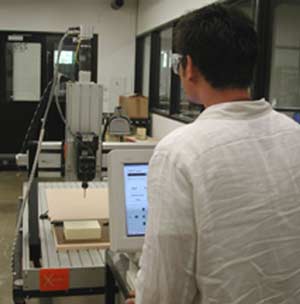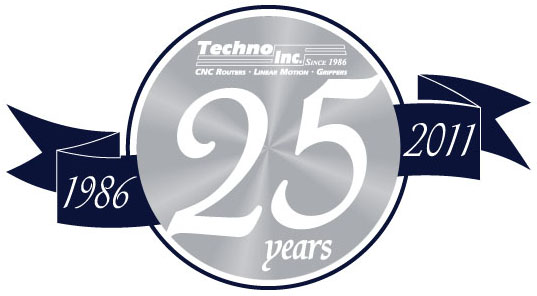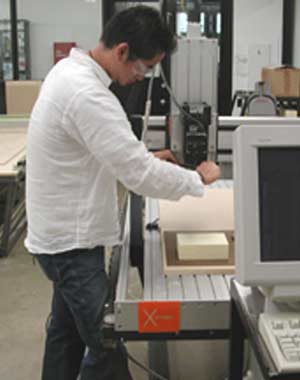


CNC Router
Educational Success Stories
 Affordable Precision Educational CNC Router Affordable Precision Educational CNC RoutereMail us at technosales@technocnc.com |
3D Rapid Modeling
| Seeing is Believing
– The Crucial Role of Prototypes in the Design Process
By Michael Plesh
While the latest computer modeling tools provide a very realistic view of a proposed design, there are often very important aspects of the design that go beyond visual appearance. One example would be that of "fit". Let’s say you are designing a project and that project utilizes a handgrip in its design. No matter how many times or what direction you rotate it in the computer, you will never be absolutely sure that it is right until you can actually put it in your hand and try it. To carry that further, a garden trowel needs to fit the hand differently than a gearshift lever or a fly swatter. The only way to determine whether the handgrip, or any other part of a design that interfaces with the human body feels correct and works for that application, is to build one and modify it until, it provides the feel that works for that application. Hard to get it right on the computer In fact, there are lots of objects whose visual appearance is very difficult to get exactly right on the computer. One reason is that rendering software alone is unable to perfectly represent the way that an object appears under certain lighting conditions, certain angles or any combination of those two. The computer comes close, but close isn’t good enough when you are about to make a decision to invest millions of dollars, bringing a new product to market. An automobile is a great example of this. Most automobile companies make heavy use of computer modeling but still depend on clay models as their final design criteria. (In fact, full size clay models are now being machined using CNC programs and large five axis machines.) Why not just use the computer? Surely it is faster and easier to manipulate. The simple fact is, that nothing beats the reality of a three-dimensional model sitting in front of you. With a 3-D model you can see, touch and feel the subtle changes in a curve or line, or the way a door handle transitions into the door panel. You can walk around and look from any angle at the way the light reflects off a given surface. This holds true for any product whose appearance is very critical, not just automobiles. In the television commercial market, art directors and producers recognize the value of having a physical model to work with, and most of them insist on it even though it would be possible, and certainly quicker, to create these models on the computer. Directors and producers have discovered that they are able to obtain a level of control over their products appearance through camera placement and lighting, they cannot achieve with just a computer model. 
Building a prototype also forces the designer to resolve issues that would be too easy to gloss over in a computer model. There are hundreds of issues that usually don’t begin to get addressed until the first prototype is built. Just exactly how do pieces fit together? Does it work the way it is intended to? How does the user hold the product? Exactly how will it be used? How does it fit in with other products that it is to be used with? Does it have the right feel? How does it look in the environment in which it will actually be used? How do the products potential purchasers react to it? You aren’t likely to get an answer to any of these questions or many others until the first prototype is built. Addressing manufacturability issues Prototyping also addresses another major concern – how easy or difficult will it be to manufacture the product. Manufacturing problems, which are not so obvious in a "computer generated" model, come into sharp focus in the actual fabrication of that model or prototype. With the latest computer modeling packages you can create virtually any shape, but is it really possible, or cost effective to make it that way in the real world? Building the design will force you to think through the different manufacturing steps and may cause you to make design changes, even very subtle ones, that will make the design much easier and less expensive to build. There are times when a model can also be used as a pattern to go directly into production with. For example, I once built a model primarily as a visual aid for a company’s marketing people to look at, prior to the manufacturing stages. As it turned out marketing loved the model and with a minor little technical change, they ended up using the model as a master, and production molds were created directly from it. Where possible, smart companies try to make a prototype that can also be used as a pattern. Here at the Art Center College of Design, we offer three classes that deal with basic model construction. The first two focus on use of manual tools and the development of hand skills, and the third is an offering into the use of the CNC routers. These are required classes for our industrial design students. After those there are more advanced RP classes that students can take, such as machine surfacing, etc. Once learned, students then make use of these skills in all areas of study. For example, our environmental design students will build topographical scale models of landscapes and buildings, and full sized pieces of furniture on our CNC Techno routers instead of cutting out pieces on a band saw. The beauty of the CNC routers is that you can define every detail of the piece in the software, send it to the router and then go do something else while the machine produces the part. While CNC machining isn’t perfect, its accuracy and appearance is far beyond what can be achieved by hand. For example; in the case of the topographic models, instead of a bunch of layers of cardboard that has been cut out on a band saw, stacked and glued together, a model would be accurately machined from a solid block of foam with every contour line layer machined to accurate tolerances, and all surfaces and edges would be clean and smooth with very little sanding necessary. While programming is somewhat of a labor-intensive process akin to cutting out the first piece by hand, once it is completed other pieces can be produced without the attention of a person except for loading raw materials and unloading finished pieces on the machine and with occasional checking to be sure the tool hasn’t worn out or broken. With today’s new "user friendly" software, even programming is becoming much quicker and less and less of a problem. Selecting a CNC router We selected the Techno machine because it is constructed on steel stress-relieved bases with hardened steel linear ways. Its shaft-and-bearing system produces very smooth, play-free motion and is an extremely rigid system that produces high-quality cuts. The machine also uses anti-backlash ballscrews. These screws have excellent power transmission due to the rolling ball contact between the nut and screws. This type of contact ensures low friction, low wear, and long life. The ballscrews also make it possible to produce wooden parts to the machine resolution of 0.0005 inch. Instead of being ballscrew-driven, the less expensive machines use rack and pinion gearing, which has too much play to make accurate cuts in small areas. Also this type of gearing wears out quickly in the dusty environment of a carpentry shop. The other main difference we found between the Techno machine and the others was that the Techno uses a servo motor to control cutting motion while other machines use stepper motors, which can give a stair-step cutting effect. With a smoother cut, sanding and finishing time is kept to an absolute minimum. Believe me when I say that this is a real plus to any Art Center student. Our students begin by defining their concept design in a computer aided industrial design software package such as Alias, FormZ and SolidWorks. (Almost any software package that produces 3-D geometry can be used, with the only limiting factor being, having the proper translators) Next their model is imported in the IGES format into a CNC programming package to produce a file that the router understands. Once the CNC program is generated it is sent to the Techno machine to cut patterns from 3-inch thick sheets of 7-pound or 15-pound density polyurethane foam, Ren shape material, or plywood from which their model or pattern is made. They also have the option to machine the top and bottom halves of a model separately, drill alignment holes in each half and then marry the two halves by inserting steel rods into the holes and gluing them together. This allows students to make models twice the depth of the machine’s cutter depth. This model can then be used as a pattern to produce a mold, or it can be used as the model itself. Our Techno Routers are not limited to just Environmental students. Product students also make use of it to machine out their models (last term it was computer speaker housings, this term it was toothbrushes) and transportation design students use it for automotive details such as rims, tires, seats and other components. This term we are teaching Fine Art students how to machine objects on them. Besides the above mentioned benefits of a designer learning basic modeling skills, there exist the fact that in the real world, when the economy is tough, and industrial design jobs are hard to find, especially for students coming straight out of school, graduates can use their model building skills to pay their bills until design opportunities come around. (Model building skills will also improve their employability and make it possible for them to earn a good living in secondary fields of employment that are closely enough related to their specialty that they can keep their skills sharp while waiting for the right opportunity to arrive) A great example of that is the opportunities that exist in the model building field that was my business. A business that produced high-quality, innovative props, patterns, "hero" products and prototypes for major studios, prop specialty shops, ad agencies, photographers, manufactures, museums. etc. My 30+ year success of my business, plus the success of thousands of other similar business, provides proof of the important role that prototypes have played and will continue to play in the product development process. Michael Plesh is currently the Director of the Technical Skill
Center, at the Art Center, College of Design in Pasadena,
California. For the past 30 plus years he has owned his own
business making props, patterns, models and prototypes for film,
architectural, industrial and ceramic work. Some samples of his
work can be viewed at www.propmakers.com |
 Techno is celebrating over 25 years of CNC technology
expertise. Our Educational sector provides industrial quality products
at educational prices with a network of award-winning Educators. We can
provide CNC Curriculums, CNC Projects, Technical Information and
Packages for any educational classroom.
Techno is celebrating over 25 years of CNC technology
expertise. Our Educational sector provides industrial quality products
at educational prices with a network of award-winning Educators. We can
provide CNC Curriculums, CNC Projects, Technical Information and
Packages for any educational classroom. Art Center College of Design
is recognized as one of the world's foremost institutions for art
and design education. Obtaining a degree from this institution has
often been compared to attending medical school, just without all
the blood. You might expect that we would be investing heavily in
the latest computer visualization tools that allow our students to
produce highly realistic 3D renderings of their design creations
and you would be right. But many people are surprised to discover
that we also insist that our students learn the skills needed to
produce an accurate physical prototype of their work, both with
conventional and computer-driven tools.
Art Center College of Design
is recognized as one of the world's foremost institutions for art
and design education. Obtaining a degree from this institution has
often been compared to attending medical school, just without all
the blood. You might expect that we would be investing heavily in
the latest computer visualization tools that allow our students to
produce highly realistic 3D renderings of their design creations
and you would be right. But many people are surprised to discover
that we also insist that our students learn the skills needed to
produce an accurate physical prototype of their work, both with
conventional and computer-driven tools.